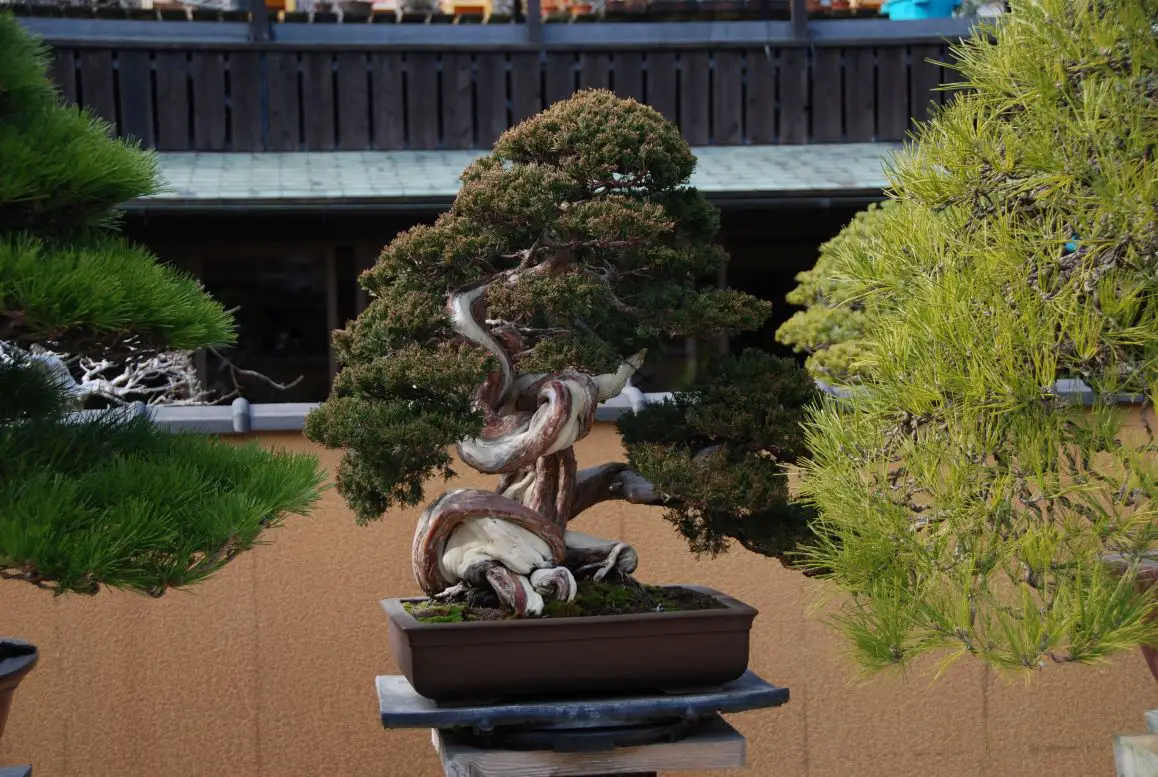For juniper bonsai, the most suitable styles include coiled trunk, formal upright, informal upright, multiple trunks, bonsai-on-rock, cascade, and windswept with deadwood features.
Best juniper bonsai styles
Thanks to their strong sprouting ability and resinous nature, juniper trees can be made into a wide variety of bonsai styles through strong wiring, hard pruning as well as an artificial creation of bonsai deadwood.
There are several traditional shapes for juniper bonsai that have been developed over centuries of bonsai cultivation. Each shape has its own unique characteristics and is suited to different types of trees and aesthetic preferences.
The followings are those juniper bonsai styles that represent the best of juniper trees’ natural characteristics in bonsai.
Coiled trunk (Bankan)
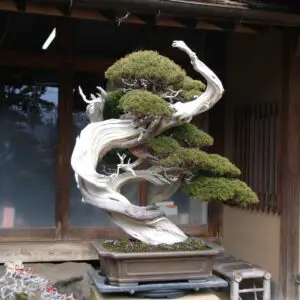
Juniper bonsai style (coiled trunk)
Coiled trunk (Bankan) is a bonsai style that is characterized by a trunk that has a pronounced S-curve or twist, which gives the tree a sense of drastic movement. In this style, the tree’s branches are arranged to enhance the S-curve of the trunk and create an interesting yet balanced overall shape.
The coiled trunk (Bankan) style is often used for bonsai trees with deadwood features and is particularly suited for juniper bonsai trees.
This style represents the trunk of a juniper tree that has been curved by prolonged exposure to wind and weather on a cliff.
Formal upright (Chokkan)
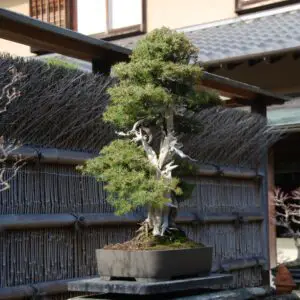
Juniper style (formal upright)
This style features a straight trunk from the bottom of the tree through the top with evenly spaced branches arranged in a balanced pattern. A good surface root (Nebari) is also a key feature because this style represents a tree that has firmly rooted in a vast open field.
Needle juniper is particularly suited for this style, often with the deadwood on the very top of the tree.
Informal upright (Moyogi)

Juniper style (informal upright)
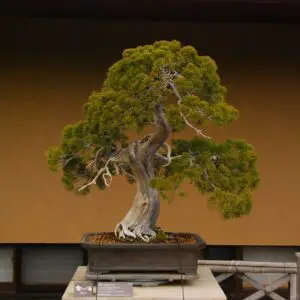
Juniper style (informal upright)
Informal upright (Moyogi) represents the trunk and branches falling and growing in different directions due to wind and other environmental influences.
This style allows juniper bonsai to grow and develop in a way that closely resembles its natural growth patterns. Juniper trees are hardy and resilient and thrive in a wide range of often difficult conditions that make the trunk grows with curves.
Multiple trunks (Kabudachi)
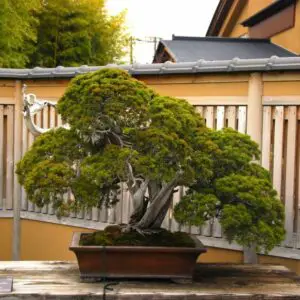
Juniper style (Multiple trunks)
The multiple trunk style (Kabutachi) is a bonsai style that involves growing multiple trunks from a single root system.
One of the key benefits of this style for juniper bonsai is that it can help to create a visually interesting composition that highlights the tree’s unique features. This can make the tree seem more impressive, with a sense of character that is difficult to achieve with other bonsai styles.
Bonsai-on-rock (Ishizuke)
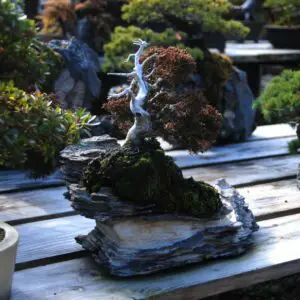
Juniper style (bonsai-on-rock)
Bonsai-on-rock (Ishizuke) represents trees that grow on the side of waterfalls or cliffs. As the name suggests, bonsai-on-rock style plants a tree on a rock.
Juniper tree is often found growing on rocky terrain or on a cliff in their natural environment. By using the bonsai on rock style, you can create a miniature representation of this natural habitat.
Also, the contrast between the rough, textured rock and the soft, delicate foliage of the juniper bonsai can create a visually striking and aesthetically pleasing composition.
Cascade (Kengai)
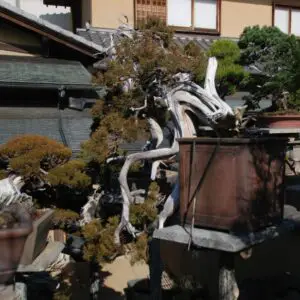
Juniper bonsai style (cascade)
The cascade style in bonsai involves a trunk that descends below the rim of the container. This style depicts trees with drooping branches leaning over rocky cliffs and beach cliffs.
This style is dramatic and striking but can be challenging to create and maintain. The cascade style involves the trunk of the bonsai hanging down below the pot’s rim, which can be difficult in balancing the tree and the container.
To address this, the tree with this style is often placed in a deeper pot or has strong/thick roots on the side opposite to the direction of the cascade.
Windswept (Fukinagashi)

Juniper bonsai style (windswept)
In the windswept style, the tree’s trunk and branches are angled in a way that suggests the tree has been shaped by strong winds blowing in one direction.
The windswept style in bonsai seeks to emulate the appearance of a tree that has been shaped and sculpted by strong winds blowing in a particular direction. This style can be particularly effective for juniper bonsai as it reflects the species’ natural tendency to grow in harsh, windy environments.
Factors to Consider When Shaping a Juniper Bonsai
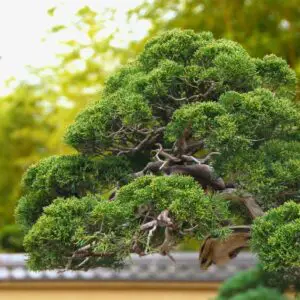
Shimpaku juniper branching
Ground rules for shaping juniper bonsai
While there are many factors that contribute to creating a stunning juniper bonsai, one of the most important is shaping and styling the tree to create a specific aesthetic. As bonsai is a natural landscape created with plants in a bonsai pot, the best way to shape a juniper bonsai tree is to imitate the shape of the tree in nature.
When growing in their natural environment, juniper trees develop twisted trunks, gnarled branches, and most notably, deadwood on branches and trunks. Incorporating these features in the styling of juniper bonsai can add visual interest and character to the tree, making it appear more natural yet artistic.
Factors to consider when choosing the shape for juniper bonsai
There are several other factors you need to consider when choosing a shape for your juniper bonsai. These include:
- aesthetic goals,
- the original shape of the tree,
- your skills and experience,
- species of juniper, and
- size of the tree.
Aesthetic goals
Your aesthetic goals should be taken into consideration.
- What kind of overall shape do you want the tree to have?
- Do you want your bonsai to look more naturalistic or rather artistic?
- Do you want to follow traditional shapes or experiment with contemporary styles?
- How will the tree look when viewed from different angles?
These are the questions you can ask yourself when choosing the style of your juniper bonsai tree.
Original shape of the tree
Certain styles may require specific characteristics of the tree, such as a certain trunk thickness or branch structure, that may not be present in all nursery stock. In the same sense, styles that require certain natural elements, such as windswept or cascade, require specific materials to achieve the desired effect.
It is important to carefully evaluate the tree and consider the possible shapes before deciding on a style to ensure that it is actually doable.
Your skills and experience
Some bonsai styles are more difficult to shape than others and styling a juniper bonsai tree with deadwood features is more challenging than shaping a tree without deadwood.
The process of creating deadwood needs skills and experience because it can weaken the tree and make it more susceptible to disease and pests when doing it wrong. Also, creating deadwood that looks natural and balanced with the overall design of the tree can require a certain level of skill and artistic vision.
Species of juniper
Different species of juniper have their own unique growth patterns and characteristics, which can influence the best shape for the tree. For example, the Shimpaku juniper is well-suited to upright styling, while the Procumbens juniper is often used in the cascade style because it grows in the form of a mat on the ground.
Size of the tree
The size of the tree can also influence the best shape to choose. A small tree with an undeveloped root system may not be able to support the weight of a cascade style, while a larger tree may be too imposing or unfitting in a bonsai-on-rock style.

